
It’s July now and the temperature is slowly dipping in Delhi. Only a few migratory birds wintered at the Yamuna biodiversity park remain. Others have left for Central Asia and Siberia. Some species of summer terrestrial migrants are expected to arrive while some others can be seen enjoying the park’s wetlands. “Red-crested pochard, a magnificent bird with a red head and an orange beak, has left,” says Sameer Gautam, an education officer at the park and an avid ornithologist.
“The arrival of this bird after a gap of over 15 years was a great feat and is indicative of how the ecology of the park is improving,” says Sameer who is studying the nesting places of black-crowned night herons. “The herons stand still at the water's edge where they hunt for food mainly at night or early morning. The wetlands provide a great habitat for the species which is quite sensitive to changes in habitat structure and composition,” says Sameer.
Sharing memories of early days, Dr Faiyaz A. Khudsar, the scientist-in-charge of the park, speaks about how the concept took root and proliferated. “It has been 15 years (2002, to be precise) since the park was first created in the Yamuna floodplains of Delhi. The park sprawls over an area of 457 acres on the flat alluvial floodplains of the Yamuna near Jagatpur village in the upstream of Wazirabad reservoir. The Centre for Environmental Management of Degraded Ecosystems, Delhi University, with support from Delhi Development Authority, developed the park through the allocation of land and grants,” he says.
The park is a saviour

“In a city which has very high concentration of particulate matter, the importance of a biodiversity park is immense. It has also emerged as a conspicuous centre for environmental education and is home to biologically rich wetlands, grassland communities, diverse fruit yielding species and several medicinal herbs,” says Faiyaz. Dr Faiyaz and Dr C.R. Babu, an influential ecologist in India, were keen on preserving the ecological integrity of the area and worked hard to bring the park to what it is today.
Sameer, who is very enthusiastic about the park, shows the indigenous, naturalised and cultivated plants of various genera. “The floodplain was destroyed over time and its verdant forests, grasslands, wetlands and wildlife lost. The introduction of exotic species, Prosopis juliflora, locally known as vilayati keekar, a thorny shrub in the barren areas of Delhi ridge and floodplains wiped out over 500 native species of Delhi. The native flora and fauna that used to exist 100 years ago, which had gone missing locally, are being re-established now,” says Sameer.
“The park acts as a natural conservation site for a specific group of endangered plants and its environment is conducive to the survival of carnivores. The nature reserve now houses about 2000 plant and animal species living in some 30 biotic communities. There was much for us to learn and the park is used for environmental education by local schools,” says Dr Ekta Khurana, a scientist working on creating this new ecological habitat.
How the park was created
“Recreating the ecological conditions (valleys, ridges, etc) and developing biotic plant communities (on the artificially-created mounds) were long and painstaking processes. Since the soil is saline, only salt-loving plants like Sueada fruiticosa could grow here. We used grasses like Leptochoal fusca to alter the soil pH from 10.5 to 7.4. After the soil became neutral, we added farmyard manure prior to planting species. Nature took its own course,” says Dr Khurana, while providing detailed accounts of the monitoring of ecological changes.
Sameer shows me around the area of the park where they bank seed genes of indigenous plants--a repository of genetic materials to preserve genetic diversity. I could also see khejari, the tree of life, a native species of Delhi. There are also native trees like teak, mitragyna, adina, dalbergia, etc. There are wetland marshes created to impound the floodwaters. The mounds in the middle serve as a habitat for several resident and migratory birds. By the year 2010, most of the trees had attained canopies. It is hard to believe that a natural environment like this could be created so quickly on the Yamuna banks. “The rate of colonisation by plants and animals in the middle of a large city exceeded our expectations,” says Sameer. “The park is able to support animals like civet, mongoose, hares, nilgai, jungle cat, wild pig and many other species,” he adds.
“Over 196 resident and migratory bird species have been recorded in the park. Eurasian Scoops Owl, European Roller, Golden Orirole, Eurasian Wryneck, Asian Paradise-flycatcher, Indian Peafowl and Common Rosefinch can be easily spotted,” Dr Khurana says.
The phase-II portion of the park, which is an active floodplain, is connected to phase-I, an inactive floodplain, through a narrow corridor. “The phase II project which comprises a mosaic of wetlands is lagging because of administrative issues like demarcation of land,” says Dr Faiyaz.
The park restricts entry to keep the impact of visitors to the minimum. But those who get to visit get valuable lessons in what ecology means.